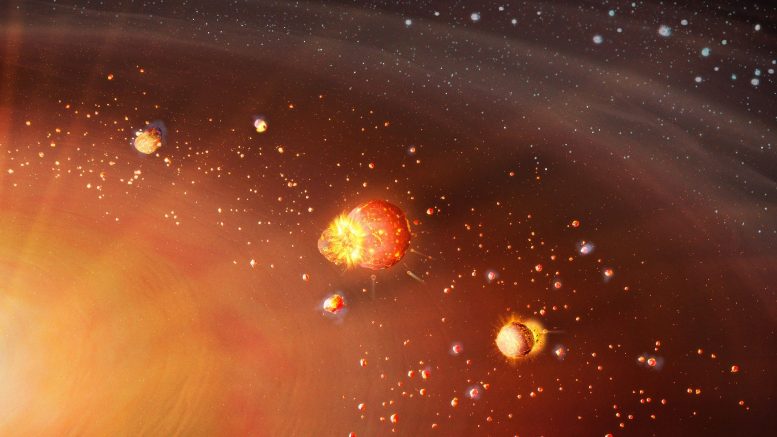
An international team of researchers from the University of Oxford, LMU Munich, ETH Zurich, BGI Bayreuth, and the University of Zurich discovered that a two-step formation process of the early Solar System can explain the chronology and split in volatile and isotope content of the inner and outer Solar System.
Their findings will be published in Science on Friday, January 22, 2021.
The paper presents a new theoretical framework for the formation and structure of the Solar System that can explain several key features of the terrestrial planets (like Earth, Venus, and Mars), outer Solar System (like Jupiter), and composition of asteroids and meteorite families. The team’s work draws on and connects recent advances in astronomy (namely observations of other solar systems during their formation) and meteoritics — laboratory experiments and analyses on the isotope, iron, and water content in meteorites.
The suggested combination of astrophysical and geophysical phenomena during the earliest formation phase of the Sun and the Solar System itself can explain why the inner Solar System planets are small and dry with little water by mass, while the outer Solar System planets are larger and wet with lots of water. It explains the meteorite record by forming planets in two distinct steps. The inner terrestrial protoplanets accreted early and were internally heated by strong radioactive decay; this dried them out and split the inner, dry from the outer, wet planetary population. This has several implications for the distribution and necessary formation conditions of planets like Earth in extrasolar planetary systems.
The numerical experiments performed by the interdisciplinary team showed that the relative chronologies of early onset and protracted finish of accretion in the inner Solar System, and a later onset and more rapid accretion of the outer Solar System planets can be explained by two distinct formation epochs of planetesimals, the building blocks of the planets. Recent observations of planet-forming disks showed that disk midplanes, where planets form, may have relatively low levels of turbulence. Under such conditions the interactions between the dust grains embedded in the disk gas and water around the orbital location where it transitions from gas to ice phase (the snow line) can trigger an early formation burst of planetesimals in the inner Solar System and another one later and further out.
The two distinct formation episodes of the planetesimal populations, which further accrete material from the surrounding disk and via mutual collisions, result in different geophysical modes of internal evolution for the forming protoplanets. Dr. Tim Lichtenberg from the Department of Atmospheric, Oceanic and Planetary Physics at the University of Oxford and lead-author of the study notes: “The different formation time intervals of these planetesimal populations mean that their internal heat engine from radioactive decay differed substantially.
“Inner Solar System planetesimals became very hot, developed internal magma oceans, quickly formed iron cores, and degassed their initial volatile content, which eventually resulted in dry planet compositions. In comparison, outer Solar System planetesimals formed later and therefore experienced substantially less internal heating and therefore limited iron core formation, and volatile release.
“The early-formed and dry inner Solar System and the later-formed and wet outer Solar System were therefore set on two different evolutionary paths very early on in their history. This opens new avenues to understand the origins of the earliest atmospheres of Earth-like planets and the place of the Solar System within the context of the exoplanetary census across the galaxy.”
This research was supported by funding from the Simons Collaboration on the Origins of Life, the Swiss National Science Foundation, and the European Research Council.
Reference: “Bifurcation of planetary building blocks during Solar System formation” by Tim Lichtenberg, Joanna Drazkowska, Maria Schönbächler, Gregor J. Golabek and Thomas O. Hands, 22 January 2021, Science.
DOI: 10.1126/science.abb3091
2 Comments
Good thing.
Preprint here: https://arxiv.org/pdf/2101.08571.pdf .
This work is an updated synthesis with lots of statistics and observational support which differ from earlier works suggesting two disk reservoirs [“Much of Earth’s nitrogen was locally sourced – Study shows two distinct origins of life-essential element in present-day planet”, Science Daily]. Here the customary Jupiter division – the largest planet and lying closest to it – is freed from being the cause but is an effect.
The cause is instead a migrating snow line separating the disk in two phases of heating from infalling molecular cloud material and cooling from such material depletion, and this affected the inner and outer disk and planets differently.
It is a complex model so one can argue about details, but they also use planetesimal thermochemical evolution to time the model and test against the meteorite record sampling timing and composition. I think this may be robust, and seems more generalizable to formation in other systems. On the other hand other systems have a more even planet distribution than ours. (Maybe they had larger feeding clouds which allowed for planet migration in a long standing disk. Or something else differed. We need to find out!.)
Some interesting predictions.
– Jupiter migration isn’t essential but cloud infall depletion and formation of all planets serve to stabilize the disk migration and lock in the dichotomy. This makes timing early and fits observations of simultaneous star and planet formation.
– The inner planets form from collisional accretion and later some amount of pebble accration. The outer planets, when they belatedly start to form, form rapidly from mostly pebble (and gas) accretion.